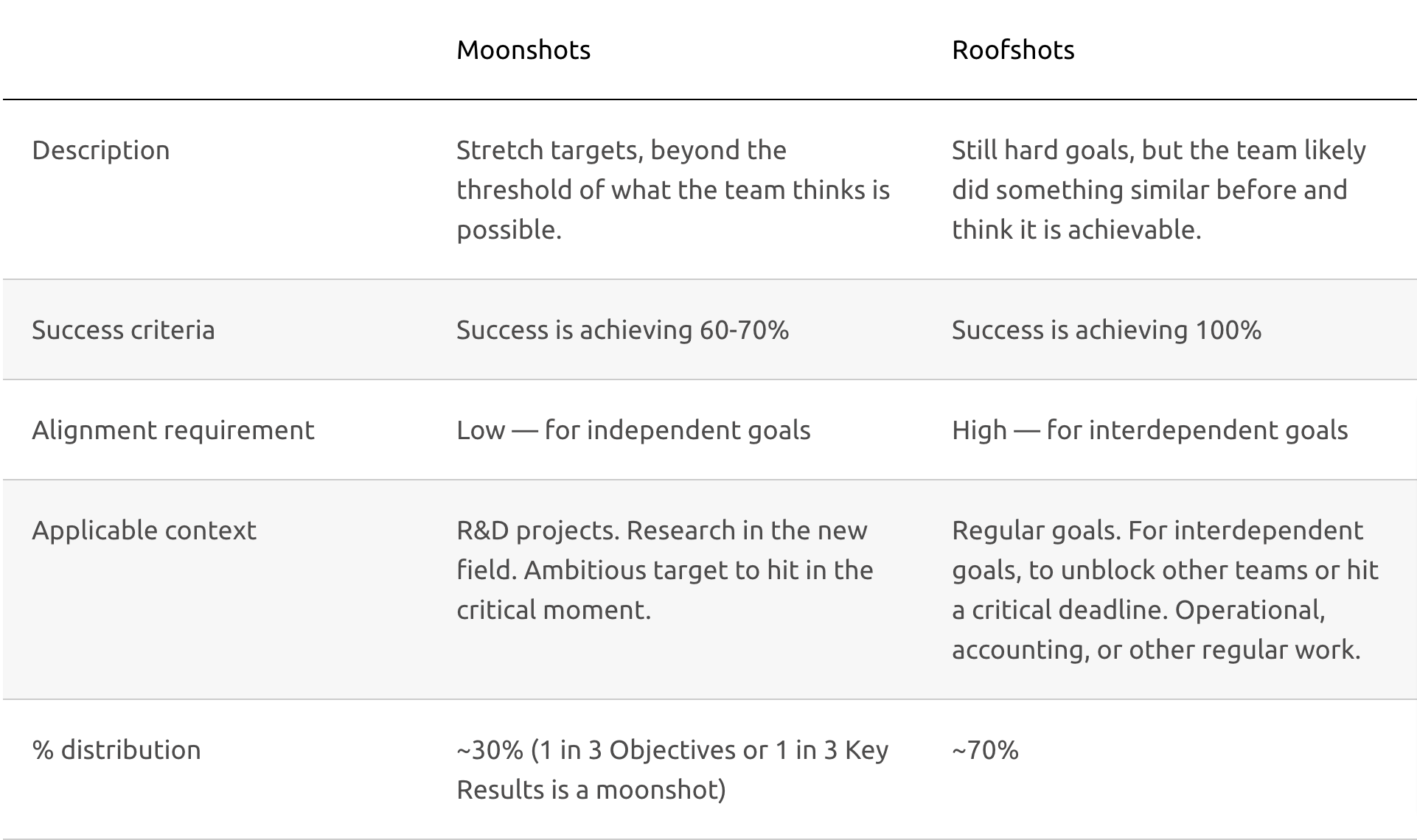
In this article, we'll dive deeper into two types of OKRs: foofshot vs moonshot, explore the difference between them and give some tips when to use each of them. We'll also provide helpful tips on when to use each type of OKR and benchmarks for scoring OKRs based on whether it's a moonshot or a roofshot goal. So, let's dive in!
Google popularized OKRs as a goal-setting framework. Among their "Ten things we know to be true" is also:
"We set ourselves goals we know we can't reach yet because we know that by stretching to meet them we can get further than we expected."
Google's OKR methodology later reflected this principle with moonshot goals.
Both Eric Schmidt in "How Google Works" and John Doerr in "Measure What Matters" mention that OKRs should be the stretch goals. Such an approach pushes the team to explore the limits of what they can reach.
Rick Klau also emphasized this point in his popular video on YouTube, when explaining how Google sets goals. He mentioned that a good grade for moonshot OKRs is 60-70%:
"If someone consistently achieves 100% of their OKRs, then the targets are not ambitious enough."
There are undoubtedly good reasons to adopt such an approach. The high goal that the team cannot easily achieve motivates them to raise difficult questions, challenge the status quo, and find creative solutions. Trying to achieve such goals broadens the team's understanding of what's possible, and what's not.
This type of goal is also called the "stretch" goal. And it's also a good analogy with stretching in gymnastics. It feels uncomfortable at first, you know that you can barely reach slightly below your knees, let alone the floor. Nevertheless, you keep trying, and over time, you're able to reach lower and lower, until you finally reach the floor. Ambitious goals are designed to work in the same way.
While moonshot OKRs have their benefits and push the team to reach beyond they think is possible, moonshot goals are not always applicable. Below are a few problems with them.
It's not pleasant to always miss your goals. We need regular feedback and confirmation that we're moving forward and accomplishing something. And high-achievers like to achieve the targets.
Ambitious goals might demotivate your team, especially in the beginning. And for organizations that are only starting with OKRs, it's also not recommended to set moonshot OKRs for the first few cycles, until the team gets used to the methodology.
Working in an unknown area is hard. And moonshots are always unknown, as you by definition target to achieve what you didn't do before. It requires a lot of effort and learning, and it's stressful. Such an approach is ok from time to time (ex. during the launch of the new product), but it is not sustainable all the time. Noone (except maybe Elon Musk) can work on the moonshot OKRs all the time.
Most of the goals are interdependent. It causes a lot of alignment issues when the teams cannot rely on each other. When the marketing team, for example, prepared all the promotional activities, but the product team has only 60% of the product and is not ready to launch, it blocks the whole process. Most teams and departments would need to be confident when other teams can deliver their targets so that the entire organization can function correctly.
Moonshot OKRs work best only for independent teams that can work on their schedule to produce breakthrough results. Such units are R&D, early-stage product teams, etc.
If you use ambitious OKRs all the time, the team would get used to it and boost the targets eventually. They'd be planning to achieve 70% from the very beginning, which would become the new norm. The targets would be especially low if you combine the OKR reviews and performance reviews.
It's like setting the clock 10 mins ahead of time to avoid being late to meetings. It works the first few days, but then you get used to it and ignore the clock.

As an alternative to a moonshot, there are roofshot goals. These are the ones that the team targets to achieve by 100%. They are still hard goals, but achievable.
Moonshot goals are essential and fundamental to the success of the OKR methodology. However, they are much harder and require a certain level of team maturity to handle them properly. Especially in the beginning, we highly recommend starting with roofshot goals only to increase OKR achievement and your team's moraale.
Below is a comparison table when to use a moonshot and when to use a roofshot, and OKR scoring system for both types of goals, answering question on how to measure OKRs. You can check more OKR goals examples in this guide.

"If you strive for the moon, maybe you'll get over the fence."
Moonshots and roofshots are two different types of OKRs, and each has its benefits and context of use. While moonshots are essential in the OKR methodology to achieve beyond expectation, roofshots are regular building blocks of your strategy. And when used wisely together, it becomes a powerful combination that aligns and engages your team to implement your mission.
Check out an OKR tool Plai that allows you to set proper moonshot and roofshot goals, track OKR activity and manage them effectively.
In this guide, you will find:
- OKR principles
- Formulas & scores
- OKR methodology
- Step-by-step guide
- Free OKR templates
- Common mistakes
Unlimited freemium for 14 days. Easy set up. No credit card required. 99% in customer satisfaction from G2 users.



